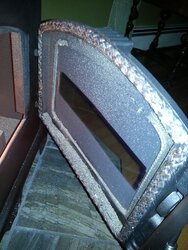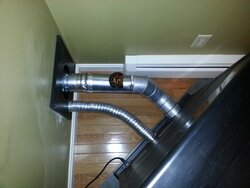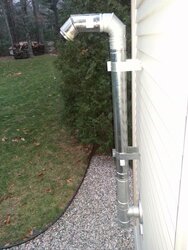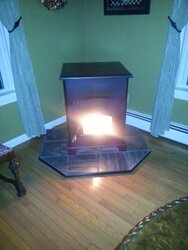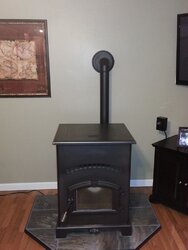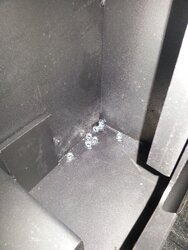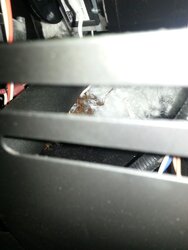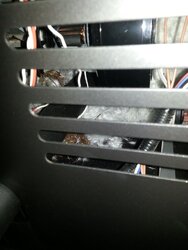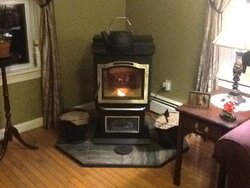New to this forum, and looking to see if anyone has had an issue with this stove. Glass door after an hour is totally covered with soot and ash. I have made several adjustments provided by the US Stove Co. No luck. Using an OAK, 3 in minimal piping thru the wall. Please feel free to chime in. Might be returning stove this Sat, installed on 11/4/12.
King 5500M Pellet Stove
- Thread starter rmuccino
- Start date
-
Active since 1995, Hearth.com is THE place on the internet for free information and advice about wood stoves, pellet stoves and other energy saving equipment.
We strive to provide opinions, articles, discussions and history related to Hearth Products and in a more general sense, energy issues.
We promote the EFFICIENT, RESPONSIBLE, CLEAN and SAFE use of all fuels, whether renewable or fossil.
You are using an out of date browser. It may not display this or other websites correctly.
You should upgrade or use an alternative browser.
You should upgrade or use an alternative browser.
- Status
- Not open for further replies.
thedude110
Feeling the Heat
Is your concern specifically with the glass or also with the heat? The ash/soot does sound excessive, but pics might help.
The amount of ash produced may be as much about the pellet as it is about the stove. What kind of pellet are you burning?
The amount of ash produced may be as much about the pellet as it is about the stove. What kind of pellet are you burning?
My issue is on with the amount of ash buildup on the glass door. The stove itself works fine and has been running 24/7 for the past week using a bag of pellets a day and heating the house very well (both 1st & 2nd flr.) I have used Natures Choice ( Home Depot) Vermont softwood pellets and New England Wood Pellets (hardwood) with the same results. I have attached some pictures of the intallation and the soot build-up. On the glass I did a swipe so you could see the amount of ash buildup. It originally was installed with the stove going out the chimney but the US Stove folks which have been very helpful during this time said this was the cause the problem. So I moved the stove to an adjacent room thru the wall, pictures attached.
Thanks for your help.
Thanks for your help.
Attachments
IHATEPROPANE
Minister of Fire
IHATEPROPANE
Minister of Fire
jtakeman
Minister of Fire
Looks as though your over EVL on the venting. If its 3"? The 2 45º, tee and 90º alone are 15 EVL points. I doubt its casuing the dirty glass issue(these US Stoves don't have great air wash systems). But I'd keep an eye oin the venting for crud buildup during the season JIC.
SmokeyTheBear
Minister of Fire
I count EVL as follows inside house 2 45's for six, 2 feet horizontal making to get to the tee outside (hopefully you don't have that tee joint inside the thimble) an EVL of 8 now outside you have the tee and the 90 at the top for 10 more making it 18 then add the 2.5 for the vertical making it 20.5 and then 1 for the horizontal portion at the top getting it to 21.5 which is over for 3" venting but fine for 4".
Air flow issues that affect the burn are one thing but you aren't going to find many stoves that do not have build up on the windows that burn wood in any form, you can not have ejecting ash and expect it to all land in the firebox area unless you have a very large fire box and that usually leads to other combustion byproducts condensing on the glass.
Air flow issues that affect the burn are one thing but you aren't going to find many stoves that do not have build up on the windows that burn wood in any form, you can not have ejecting ash and expect it to all land in the firebox area unless you have a very large fire box and that usually leads to other combustion byproducts condensing on the glass.
I count EVL as follows inside house 2 45's for six, 2 feet horizontal making to get to the tee outside (hopefully you don't have that tee joint inside the thimble) an EVL of 8 now outside you have the tee and the 90 at the top for 10 more making it 18 then add the 2.5 for the vertical making it 20.5 and then 1 for the horizontal portion at the top getting it to 21.5 which is over for 3" venting but fine for 4".
Air flow issues that affect the burn are one thing but you aren't going to find many stoves that do not have build up on the windows that burn wood in any form, you can not have ejecting ash and expect it to all land in the firebox area unless you have a very large fire box and that usually leads to other combustion byproducts condensing on the glass.
I value your input.
Turns out that the stove I had was defective. Returned it last nite and picked up another. This morning there was very minimal buildup on the glass. Fan is much quieter.
About your EVL count, what if I removed the 12" pipe above the T and just use a 3 ft rise, would that be better.
Thanks again.
BTW joint is outside the thimble and sealed.
SmokeyTheBear
Minister of Fire
Is that 3" or 4" vent?
4" vent is called for with that set up.
A revision in EVL of 0.5 isn't likely to help matters at all. The EVL killer is all those bends.
Now exactly what was defective about that stove?
4" vent is called for with that set up.
A revision in EVL of 0.5 isn't likely to help matters at all. The EVL killer is all those bends.
Now exactly what was defective about that stove?
Is that 3" or 4" vent?
4" vent is called for with that set up.
A revision in EVL of 0.5 isn't likely to help matters at all. The EVL killer is all those bends.
Now exactly what was defective about that stove?
It is a 3" vent and I did exactly what the US Stove Folks told me to do. I even mentioned all the turns and length of pipe I was using and provided those pictures I posted earlier. They said it was perfect. What they were actually trying to do was blame the installation for the cause of my problems. Tony the Rep at US Stove did say that 2 45's, 1 90, 4' rise and the exhaust was the limit. Plus the fact I have the OAK. Several Reps said that these stoves should have no more than 180 degree turns.
The new stove I have now has been burning for approx 12 hrs now with a very light film on the glass.
The old stove not sure what the issue was, but my guess is, as they said, it could have been a bad draft fan. Since it was under 30 days I was allowed to return and swap it out.
Funny thing though, this is actually my third stove. When I picked up the second one and started to unpack it last nite in the truck I noticed a nest in the back where the fans are. Posted pictures. Also, the firebox had about a half dozen bolts in the corner. Brought that sucker back and have my third. Just glad I noticed it before hooking it up. Could have been nasty. LOL
Thank-you for your input.
Attachments
Is your concern specifically with the glass or also with the heat? The ash/soot does sound excessive, but pics might help.
The amount of ash produced may be as much about the pellet as it is about the stove. What kind of pellet are you burning?
Right now I am burning NEWP (Hardwood)
Don't know if you saw my post about returning stove and getting a replacement. All seems well now.
SmokeyTheBear
Minister of Fire
It is a 3" vent and I did exactly what the US Stove Folks told me to do. I even mentioned all the turns and length of pipe I was using and provided those pictures I posted earlier. They said it was perfect. What they were actually trying to do was blame the installation for the cause of my problems. Tony the Rep at US Stove did say that 2 45's, 1 90, 4' rise and the exhaust was the limit. Plus the fact I have the OAK. Several Reps said that these stoves should have no more than 180 degree turns.
The new stove I have now has been burning for approx 12 hrs now with a very light film on the glass.
The old stove not sure what the issue was, but my guess is, as they said, it could have been a bad draft fan. Since it was under 30 days I was allowed to return and swap it out.
Funny thing though, this is actually my third stove. When I picked up the second one and started to unpack it last nite in the truck I noticed a nest in the back where the fans are. Posted pictures. Also, the firebox had about a half dozen bolts in the corner. Brought that sucker back and have my third. Just glad I noticed it before hooking it up. Could have been nasty. LOL
Thank-you for your input.
Your stove is over EVL with 3" pipe you have 270 degrees of bends not counting your termination cap. 2 45's and 2 90s (that tee is a 90 degree bend).
One other thing that vertical rise outside the house will cause more soot and ash to precipitate out in the vent instead of exiting the system.
Having excessive EVL leads to air flow problems and that causes bad burns which requires more cleaning on your part and a larger air resistance for your draft fan to overcome causing unnecessary wear on that fan.
ETA: And even worse is that the outside portion of that venting looks from the picture like it isn't going vertical on the 4' section and with a slight upslope on the portion going to the termination cap. In other words it looks like the outside is going downwards. It could be the angle you took the picture from however best you check it.
Your stove is over EVL with 3" pipe you have 270 degrees of bends not counting your termination cap. 2 45's and 2 90s (that tee is a 90 degree bend).
One other thing that vertical rise outside the house will cause more soot and ash to precipitate out in the vent instead of exiting the system.
Having excessive EVL leads to air flow problems and that causes bad burns which requires more cleaning on your part and a larger air resistance for your draft fan to overcome causing unnecessary wear on that fan.
ETA: And even worse is that the outside portion of that venting looks from the picture like it isn't going vertical on the 4' section and with a slight upslope on the portion going to the termination cap. In other words it looks like the outside is going downwards. It could be the angle you took the picture from however best you check it.
I did check the vertical piping outside and it is plump/vertical. Purchasing 4 in pipe is not an option for me. What if I removed the vertical and cleanout T and just put the exhaust on that horizontal pipe coming out of the thimble? Would that be an option?
Value your opinion.
SmokeyTheBear
Minister of Fire
I did check the vertical piping outside and it is plump/vertical. Purchasing 4 in pipe is not an option for me. What if I removed the vertical and cleanout T and just put the exhaust on that horizontal pipe coming out of the thimble? Would that be an option?
Value your opinion.
What does your stove manual say about any needed vertical rise in the venting to provide a natural draft to prevent smoke back in case of power failure?
What does your stove manual say about any needed vertical rise in the venting to provide a natural draft to prevent smoke back in case of power failure?
It says min 3 ft vert. pipe to prevent back draft in the event of a power failure. Also that would not work since my OAK is right in the wall thimble. Guess that won't be an option then.
skibladerj
Member
Simpy fix to your glass issue your... you air wash is coved by gasket.about 6inches the of glass at the bottom of the glas should have no gasket. Look on the ussc website unter videos on replacing the gasket on the glass.
Ended up returning it to TS for a full refund. Purchased a Harman P68 instead and I am very pleased with the results. Very low maintenance. Heating my 2200 sq ft home at a comfortable 75 degrees.thinking about buying one of these, its an old post what was the result..
Good Luck
Attachments
Last edited:
- Status
- Not open for further replies.
Similar threads
- Replies
- 17
- Views
- 2K
- Replies
- 848
- Views
- 25K
- Replies
- 7
- Views
- 1K


